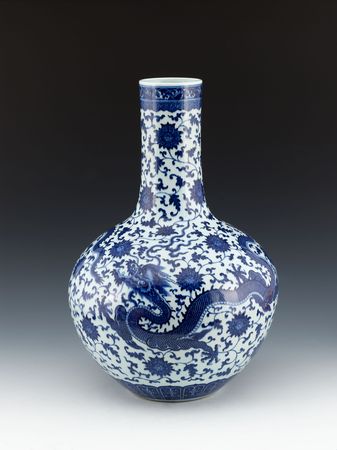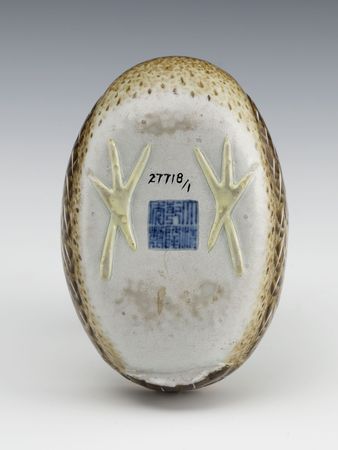"Sovereign Splendour, Imperial porcelain from Shanghai" @ the Gemeentemuseum Den Haag
Chinese vaas met fencai decoratie van Indiase lotusbloemen en plastische figuurtjes van spelende kinderen, Qianlong dynastie (1736-1795), 31,1 cm, collectie Shanghai museum
THE HAGUE.- Only the best was ever good enough for the court of imperial China. It had its own special factories using the highest quality porcelain, the most virtuoso craftsmen and the finest pigments to produce the crème de la crème of Chinese ceramics. Now, for the very first time, a hundred of these masterpieces from the collection of the Shanghai Museum are exhibited outside Asia. However, the Sovereign Splendour exhibition at the Gemeentemuseum Den Haag does not present these magnificent examples of imperial porcelain in isolation: through a focus on the symbolism and significance of their decoration, it also introduces the public to the fascinating myths and traditions of pre-revolutionary China.
In the early seventeenth century, it became fashionable in the Netherlands to collect Chinese porcelain. Pieces imported by the Dutch East India Company (VOC) were in great demand at auction, despite the high prices they fetched. However, the objects that were so popular in this country were specifically made for export and were of far lower quality that the porcelain produced for the imperial court.
During the Ming (1368-1643) and Qing (1644-1911) dynasties, countless masterpieces were produced and passed down from generation to generation. A key difference between ordinary porcelain and that of the imperial court is the mainly ceremonial, rather than domestic, nature of the latter. Following the 1911 revolution that ended the reign of the last emperor, Xuantong, what survived of the imperial porcelain collection was split up. The Shanghai Museum possesses the largest collection of it in China and has now, exactly a century after the fall of imperial China, agreed to exhibit a representative selection here at the Gemeentemuseum.
The pieces are of the very finest quality and illustrate the sophisticated lifestyle enjoyed by the emperors over many centuries. An example of this quality and sophistication is a charming quail-shaped lidded box with a Fencai glaze, dating from the time of Emperor Qianlong (1736-1795). The little bird’s eyes, beak and feathers are depicted in minute naturalistic detail and true-to-life colour. The meticulous care of the maker is particularly evident when the box is turned over to reveal two tiny legs depicted in relief on the bottom.
The paintwork on the dishes, vases and jars is not purely ornamental, but often includes auspicious symbols. For example, bats and clouds stand for ‘superabundant everyday happiness’, while the pomegranate, peach and citron symbolise ‘many sons and long life’ and the five-clawed dragon is deemed to represent imperial power.
The opportunity to hold this exhibition came about as the result of a very special relationship between Dutchman Henk Nieuwenhuys and the Shanghai Museum. A few years ago, Nieuwenhuys donated his private collection of Chinese export porcelain to the Shanghai Museum, where it is now on permanent display.
The exhibition is accompanied by a lavishly illustrated catalogue: T.M. Eliëns (ed.), Imperial Porcelain from the Shanghai Museum (Waanders, € 27.95), sponsored by Vanderven & Vanderven Oriental Art.
Pot met lotusslingers in onderglazuur blauw, Yongzheng (1723-1735), 32,6 cm hoog, collectie Shanghai museum
Rechthoekige vaas met buisvormige oren en de tekens ‘geluk’ en ‘lang leven’ in onderglazuur blauw, Qianlong (1736-1795), 30,3 cm hoog, collectie Shanghai museum
Vaas met draken tussen gevlochten lotusranken in de onderglazuur blauw, Qianlong (1736-1795), 60,4 cm hoog, collectie Shanghai museum
Doosje in de vorm van een kwartel met fencai-glazuur, Qianlong (1736-1795), 5,4 cm hoog, collectie Shanghai museum
Doosje in de vorm van een kwartel met fencai-glazuur, Qianlong (1736-1795), 5,4 cm hoog, collectie Shanghai museum

/https%3A%2F%2Fprofilepics.canalblog.com%2Fprofilepics%2F1%2F0%2F100183.jpg)
/https%3A%2F%2Fstorage.canalblog.com%2F03%2F02%2F119589%2F96711876_o.jpg)
/https%3A%2F%2Fstorage.canalblog.com%2F11%2F31%2F119589%2F94773502_o.jpg)
/https%3A%2F%2Fstorage.canalblog.com%2F20%2F83%2F119589%2F94772815_o.jpg)
/https%3A%2F%2Fstorage.canalblog.com%2F26%2F72%2F119589%2F75604929_o.jpg)
/https%3A%2F%2Fstorage.canalblog.com%2F59%2F60%2F119589%2F26458628_o.jpg)








/http%3A%2F%2Fstorage.canalblog.com%2F51%2F84%2F119589%2F122518624_o.jpg)
/http%3A%2F%2Fstorage.canalblog.com%2F42%2F87%2F119589%2F112989160_o.jpg)
/http%3A%2F%2Fstorage.canalblog.com%2F28%2F52%2F119589%2F112495720_o.jpg)
/http%3A%2F%2Fstorage.canalblog.com%2F12%2F27%2F119589%2F96148405_o.jpg)